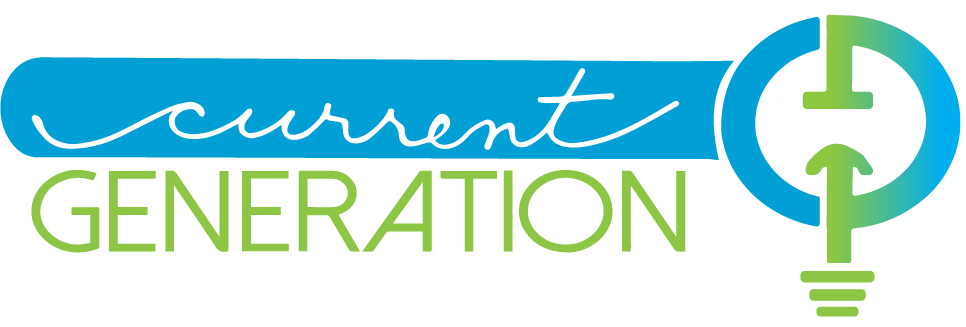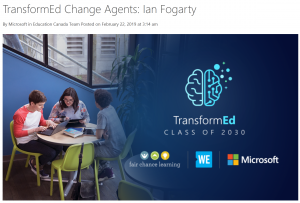Microsoft TransformED published an article about some of the work that my students are doing. Please note, that I am one of 3 CO-FOUNDERS of Engineering Brightness including John Howe and Tracey Winey of Fort Collins, Colorado.
TransformEd Change Agents: Ian Fogarty
By Microsoft in Education Canada Team Posted on February 22, 2019 at 3:14 am

For TransformEd, Microsoft Innovative Educator Fellow Ian Fogarty shared his thoughts on a few of our questions about the Class of 2030. Ian is a chemistry and physics teacher, the co-director of SHAD at the University of New Brunswick, and one of the co-founders of CurrentGeneration.org, an organization that collaborates with students to impact light poverty. He has fantastic insights into student engagement, collaboration, and working with technology for good!
•••
What are some of the most surprising outcomes of personalized learning in your classroom?It’s amazing where students will go if they can leverage a personal strength or passion to explore an area of insecurity and bring about long-lasting, deep learning that changes the trajectory of their lives. I personalize my students’ learning by conducting large semester projects in addition to my essential content and skills in physics and chemistry. I often begin by asking a few key questions. What do you do for fun? What do you want to do after high school? The answers help direct their project.
-Jay was excited by improv. He wrote, directed, and performed a Chemistry Road Show at local schools. Decades later, as a lead on Broadway, he recites chemical recipes and thermodynamics from high school.
-Cassie learned coding, 3D printing, and bioengineering to invent an inexpensive prosthetic suitable for her mom, who’s an amputee. It changed the direction of her life from music to mechatronic engineering.
-Timothy experienced such social anxiety that he had never given an oral presentation. Because of his passion for social justice around light poverty and the lights that he built in physics class, he spoke for 20 minutes with Anthony Salcito at ISTE Denver, presented a poster at Princeton IEEE STEAM, and gave an eloquent talk to provincial and federal politicians. He is now on the Dean’s List in a criminology degree, where he advocates and debates confidently and competently.
All of these personal mini-miracles happened because students leveraged their strengths to explore areas of insecurity in carefully designed, personalized science projects.
How do you confront challenges to equity in technology and education?There are 1.3 billion people in the world who live in light poverty, which means that when the sun sets, they choose between sitting in the dark or burning kerosene, brush, or candles. All of these options have serious negative socio-economic, health, environmental, and educational ramifications. For example, how can they do homework under those conditions?
This is a problem that my CurrentGeneration.org students can solve as they learn their science curriculum in a transdisciplinary way, while simultaneously developing into empathetic global citizens. My students practice their writing and public speaking to communicate with our global friends living in light poverty to gain an understanding that allows them to complete the first two steps of the design-thinking cycle: empathize and define. They use physics, economics, and art to ideate and create a prototype. The prototypes are tested in the classroom and then sent to our global friends living in light poverty, where they continue the testing. Their feedback is used for the next iteration.
CurrentGeneration.org also seems to be addressing another inequity gap in STEM/STEAM education: gender. Approximately 80% of the students are female. This in-school and after-school project changes the perception that engineering is a cold-hearted way to make a new mousetrap. Instead, it’s a warm-hearted way to make the world better.
What benefits do you see when student voice is encouraged?Voice is the path from passive to engaged. We give voice to students both in and out of class. We still cover all the Science 12 content; however, at each reporting period, the power is handed to the students as a group to decide on the formula that will be used to calculate a grade. This process develops communication, collaboration, critical thinking and empathy in the students. It also makes them feel as though the students and teachers are on the same team, playing this game of learning. The first year I employed this strategy, the intrinsic motivation resulted in 100% attendance in an early-morning grade 12 class during the final semester.
The second step is to design personalized projects that allow students to use their creativity and have a voice to solve real problems in their community. One group designed a helmet that would send data to the coach about the impacts experienced by athletes to help prevent secondary injury. Cass changed her trajectory from music to mechatronic engineering when she built an inexpensive prosthetic for people like her mother. Brae overcame his fear of speaking in class and was able to keynote on stage with Michael Fullan and 300 other international educators, speaking about his work designing solar powered solutions for the Jane Goodall Foundation.
•••
To find out more about future-ready learning and the skills that will matter most for the Class of 2030, head to microsoft.ca/TransformEd. For courses, resources, and a community of edtech-empowered educators, visit education.microsoft.com. To learn about Microsoft education tools and classroom technology, or to schedule free PD for your school, take a look at microsoft.ca/education.

